| |
|
|
|
|
|
|
|
SXSW is starting this weekend, and documentary news will quickly be dominated by the now established film part of this festival. Here are a few resources to find out what is going on and what films will likely get a lot of coverage.
Go right to the source for speeches and film screenings information at the SXSW Film page.
Documentaries about entertainment personalities will certainly dominate much of the film news coming out of Austin.  A Willie Nelson documentary directed by Billy Bob Thornton will be shown, and Conan O’Brien’s tour documentary will premiere. But don’t forget about some of the smaller films.
A good spotlight on some of the Documentary Shorts that will be shown at SXSW.  Many films are mention but the highlights include: Frank Fairfield, My Big Red Purse and Library of Dust.
If you are looking for just films in general,  check out this list of possible hits.
If you are fortunate enough to be going to SXSW, have a great time. Â The rest of us will be watching from afar; awaiting the day when these documentaries are distributed to a wider audience.
|
|
|
|
| |
|
|
|
|
|
|
|
One of our writers are has been working on an informative social media blog, that we wanted to point you to if you have an interesting in social media.  The site is LLSocial.com and it also features a social media podcast that offers news and interviews.
As a note to our long time fans of the Documentary Films. Net site.  We are working to get more reviews and information on the site.  If you have ideas for content or format changes, let us know.  We want to provide relevant information, but outside time constraints on our writers and editors has had much of the content come to a stop, and we apologize for that.
|
|
|
|
| |
|
|
|
|
|
|
|
Beverly Hills, CA — Nominee credits for Best Documentary Feature nominee “The Cove” have been determined by the Academy of Motion Picture Arts and Sciences’ Documentary Branch Executive Committee. Credits are as follows:
“The Cove” – Louie Psihoyos and Fisher Stevens
Academy rules for the documentary feature category state that a maximum of two persons may be designated as nominees, one of whom must be the credited director, and the other of whom must have a producer or director credit. Psihoyos is the film’s director, Stevens has a producer credit.
|
|
|
|
| |
|
|
|
|
|
|
|
U.S. DOCUMENTARY COMPETITION
This year’s 16 films were selected from 862 submissions. Each film is a world premiere.
Bhutto (Directors: Jessica Hernandez and Johnny O’Hara; Screenwriter: Johnny O’Hara)—A riveting journey through the life and work of recently assassinated Benazir Bhutto, former Pakistani prime minister and a polarizing figure in the Muslim world. World Premiere
CASINO JACK & The United States of Money (Director: Alex Gibney)—A probing investigation into the lies, greed and corruption surrounding D.C. super-lobbyist Jack Abramoff and his cronies. World Premiere
Family Affair (Director: Chico Colvard)—An uncompromising documentary that examines resilience, survival and the capacity to accommodate a parent’s past crimes in order to satisfy the longing for family. World Premiere
Freedom Riders (Director: Stanley Nelson)—The story behind a courageous band of civil rights activists called the Freedom Riders who in 1961 creatively challenged segregation in the American South. World Premiere
Gas Land (Director: Josh Fox)—A cross-country odyssey uncovers toxic streams, dying livestock, flammable sinks and weakening health among rural citizens on the front lines of the natural gas drilling craze. World Premiere
I’m Pat _______ Tillman (Director: Amir Bar-Lev)—The story of professional football star and decorated U.S. soldier Pat Tillman, whose family takes on the U.S. government when their beloved son dies in a “friendly fire” incident in Afghanistan in 2004. World Premiere
Jean-Michel Basquiat: The Radiant Child (Director: Tamra Davis)—The story of artist Jean-Michel Basquiat, whose work defined, electrified and challenged an era, and whose untimely death at age 27 has made him a cultural icon. World Premiere
Joan Rivers: A Piece of Work (Directors: Ricki Stern and Annie Sundberg)—A rare, brutally honest glimpse into the comedic process and private dramas of legendary comedian and pop icon Joan Rivers as she fights tooth and nail to keep her American dream alive. World Premiere
Lucky (Director: Jeffrey Blitz)—The story of what happens when ordinary people hit the lottery jackpot.
World Premiere
My Perestroika (Director: Robin Hessman)—Intimately tracking the lives of five Muscovites who came of age just as the USSR collapsed and are adjusting to their post-Soviet reality, My Perestroika maps the contours of a nation in profound transition. World Premiere
The Oath (Director: Laura Poitras)— Filmed in Yemen, The Oath tells the story of two men whose fateful encounter in 1996 set them on a course of events that led them to Afghanistan, Osama bin Laden, 9/11, Guantanamo, and the U.S. Supreme Court. World Premiere
Restrepo (Directors: Sebastian Junger and Tim Hetherington)—Sebastian Junger and Tim Hetherington’s year dug in with the Second Platoon in one of Afghanistan’s most strategically crucial valleys reveals extraordinary insight into the surreal combination of back breaking labor, deadly firefights, and camaraderie as the soldiers painfully push back the Taliban. World Premiere
A Small Act (Director: Jennifer Arnold)—A young Kenyan’s life changes dramatically when his education is sponsored by a Swedish stranger. Years later, he founds his own scholarship program to replicate the kindness he once received. World Premiere
Smash His Camera (Director: Leon Gast)—Jacqueline Kennedy Onassis sued him, and Marlon Brando broke his jaw. The story of notorious, reviled paparazzo Ron Galella opens a Pandora’s Box of issues from right to privacy, freedom of the press and the ever-growing vortex of celebrity worship. World Premiere
12th & Delaware (Directors: Rachel Grady and Heidi Ewing)—The abortion battle continues to rage in unexpected ways on an unassuming corner in America. World Premiere
Waiting for Superman (Director: Davis Guggenheim)—Waiting for Superman examines the crisis of public education in the United States through multiple interlocking stories—from a handful of students and their families whose futures hang in the balance, to the educators and reformers trying to find real and lasting solutions within a dysfunctional system. World Premiere
|
|
|
|
| |
|
|
|
|
|
|
|
By Bryan Newbury
November 18, 2009
 Recently, The New York Times ran a piece speculating upon what our thankfully nearly late decade should be dubbed. Among other ghastly appellations were The Era of Misplaced Anxiety and The Decade of Overshoot, to say nothing of the North going South and The Decade of Disruptions. Watching The Garden while looking back at the aughts, one is tempted to leap to hyperboles of wickedness so pernicious that he might be accused of striking at least a passing resemblance to the Yahwist. Recently, The New York Times ran a piece speculating upon what our thankfully nearly late decade should be dubbed. Among other ghastly appellations were The Era of Misplaced Anxiety and The Decade of Overshoot, to say nothing of the North going South and The Decade of Disruptions. Watching The Garden while looking back at the aughts, one is tempted to leap to hyperboles of wickedness so pernicious that he might be accused of striking at least a passing resemblance to the Yahwist.
The past decade has been nothing if not a paean to fiendishness. Attempts to define it and label it fall short not for lack of nuance; rather, these years burden the sensibilities with iniquities every bit as vile as they are complete that they bewilder the observer beyond reason. If one is inclined to bemoan the violations of American empire against its subjects and enemies, he is bound to recognize the equally dreadful thoughts and actions of the victims. As Wall Street speculated away the wealth of many nations, it did so with the consent of its victims, who were hoping for a share in the Sachs spoils. This decade has been an age without victims… all have come well short of the glory, or so says the reporting.
The Garden goes further than any documentary of the decade in defining an age where everything good has suffered from the rot of unthinking avarice. The story is simple enough and much to familiar in narrative arc. To be as succinct as possible, there once was a community garden in South Central Los Angeles tended by its (largely Latino) residents with nearly transcendental results. The plot was purchased by the city from a developer, whose irredeemably black soul shall be dealt with presently, following the riots of 1992. As time went on, the land was observed to have a great value in graft by an unscrupulous city councilwoman and erstwhile community activist. The land was sold back to the contemptible fellow in an extralegal process with the help of the corrupt councilwoman and the clout of the nefarious activist in order to line their pockets.
It would be a pedestrian tale were it not for the fact that the South Central Farmers had done something that is all too rare in our age: they made something beautiful and good.
To recount the abhorrent acts of venality and violence that occur would do a disservice to a film that should be seen by all. It is difficult to watch at times and equally difficult to describe without resorting to sloganeering reminiscent of the Paris commune. What transpires is a depiction of solid, honest people – even when they are at their worst, even as they battle amongst themselves – being thrown to the rapacious hydra that has become fully evolved in our America: the three devouring heads of corporatism, cronyism and complacency.
The corporatism is easy enough to understand. Ralph Horowitz is a grasping bastard bereft of a soul that sells high and buys low (truth be told, sells same buys same, but with the passing of time the depiction fits, as does the rhyme) and eventually refuses to sell higher still because of his contempt for humanity. In short, a businessman.
Juanita Tate and Jan Perry were likely human at one time. Perry became involved in institutional politics, which inevitably corrupts. If there is doubt on that, research what your Congresspeople have received in contributions from insurance and pharmaceutical lobbyists within the last few years. Tate saw her golden ticket and punched it after years of activism. The examples of Tate and Perry set against that of Horowitz clearly illustrate a growing cognitive dissonance in popular thought. Business is irreparably amoral and government is irrevocably unethical. Meanwhile, business and government present themselves as adversaries. Business creates wealth which government taxes and government manages to regulate while business prevaricates. This becomes pure theatre when both aspire to similar aims. So, is it complacency when the victims of business protest the government charged with protecting them and their counterparts wail about those same agents advancing their cause?
In many ways, yes. Even as we inveigh against self-important celebrities sticking their noses in issues of public policy, we ignore every plight that doesn’t draw a camera. (The Garden is replete with celebrity appearances, from Danny Glover and Darryl Hannah to Joan Baez and Willie Nelson.) It is only natural to be consumed with outrage as the film draws to a close, but how often are we speechless witnesses to crimes such as these? What use is any of it if, to borrow from Phil Ochs, it wouldn’t interest anybody outside of a small circle of friends?
It is nearly impossible to encapsulate the topics orbiting around the basic story told by The Garden. To give an honest and in depth accounting of the racial issues would require more space than is available here. When the spectre of antisemitsm is raised in regard to Mr. Horowitz to a bemused group of Mexican Americans who are in jeopardy of losing something great they’ve created, when we see African Americans on both sides of the fight, when we see those African Americans endeavoring to steer the issue into a brown on black battle (one area among many that Dan Stormer distinguishes himself as both ethical and intelligent) and when we see the LAPD exercise their trademark brutality on the South Central Farmers it defies definition. It seems to simply be, which might be the ultimate indictment on us, our decade, our species.
The Garden is a morality tale equally simple and multi-faceted where evil prevails. It reminds this reviewer of a Woody Guthrie statement that new and better curse words are required to describe certain people. It is a ballad depicting the conflict between verdancy and decency with the bankrupt ideology of mammon, the clash of humanity and saurian predation. Hopefully, it is the coda to a decade marred with needless acquisitiveness and an instructive document informing us of how we’ve gone wrong. In any event, it is as useful an interpretation of where we are and how we got there as the medium is likely to give us.
—–
The Garden
Written & Directed by Scott Hamilton Kennedy
2008, Color, 80 minutes
|
|
|
|
| |
|
|
|
|
|
|
|
By Bryan Newbury
August 7, 2009
 Bitch set me up. Bitch set me up.
Chances are, when someone outside of Washington, D.C. mentions the name Marion Barry, those four words will enter into the conversation. Like all things dealing with race in the United States, the jovial treads a very thin line before falling off of the precipice into the hateful. In the Middle West, we have a longstanding tradition of jovial skewing towards hateful. Hopefully, these little jabs come off for entertainment over beers. To claim that there is never a bit of racially charged humor in those bull sessions would be duplicitous. At the risk of breaking a little news, these conversations still happen in our new postracial America.
The unwelcome news in postracial Obaman America, of course, is that the jovial is rapidly ceding territory to the hateful. For some reason, farmer-tanned minions throughout our land seem unwilling to share in the collective joy we right-thinking individuals relish in regarding our first African-American president, our first Latina Supreme Court justice and a new release by Eminem. “White America,†whatever that might mean, is astonishingly adept at adopting a mentality of victimhood, and it appears that the lightly satiric Midwestern quips are increasingly becoming drowned out by verbiage more reminiscent of the Old South. Midwesterners tell funny stories, they say. Southerners tell stories funny. There is a world of difference.
When one throws something like The Nine Lives of Marion Barry into this confusing milieu, the results will be decidedly mixed.
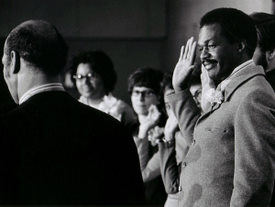 Outside of the District, and especially outside of the black community, the consensus is that Mr. Barry is a base pipe toking womanizer who has outlived his public usefulness. Inside of the District and its black community, the former is a forty-sixty proposition. The sixty readily identify with Mr. Barry’s trials and tribulations, having experienced the siege of narcotics and violence in their community, having lived through broken homes bought about in many respects by the willful efforts of the Anglo power structure to break those homes and communities. As the film points out early on, the District operated as an odd plantation protectorate well into the 1970’s, being administered by gents like John McMillan of South Carolina . Barry was indispensable in the fight to “Free D.C.†and make it possible for citizens of the overwhelmingly black city to enjoy basic rights other Americans take for granted, such as electing a city council and mayor.* Outside of the District, and especially outside of the black community, the consensus is that Mr. Barry is a base pipe toking womanizer who has outlived his public usefulness. Inside of the District and its black community, the former is a forty-sixty proposition. The sixty readily identify with Mr. Barry’s trials and tribulations, having experienced the siege of narcotics and violence in their community, having lived through broken homes bought about in many respects by the willful efforts of the Anglo power structure to break those homes and communities. As the film points out early on, the District operated as an odd plantation protectorate well into the 1970’s, being administered by gents like John McMillan of South Carolina . Barry was indispensable in the fight to “Free D.C.†and make it possible for citizens of the overwhelmingly black city to enjoy basic rights other Americans take for granted, such as electing a city council and mayor.*
The Nine Lives of Marion Barry follows the rise and fall and resurrection and fall and rise and stumbling and rising again of Barry alongside that of his city, weaving in and out from historical context to his 2004 run for city council from Ward Eight, a notoriously hard-hit area of our nation’s capital. There is little hint of hagiography here. Effi Slaughter, Barry’s ex-wife, gets the lion’s share of interview time. It is easy to relate to her. Probably as easy as District residents find it to relate to their former mayor. She gives a cogent reckoning of her relationship with Mr. Barry, from his charismatic rise in D.C. activism and politics to his 1990 arrest and beyond.
–Read the rest of this entry »
|
|
|
|
| |
|
|
|
|
|
|
|
By David Loftus
June 24th, 2009
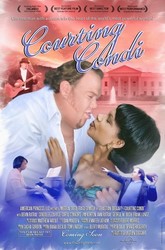 By now, many of us have grown accustomed to films that make us uncomfortable. By now, many of us have grown accustomed to films that make us uncomfortable.
There have been documentaries that showed us unpleasant truths, whether old (“The Fog of Warâ€) or new (“An Inconvenient Truthâ€), and plenty of pop films which thrived on humiliating their heroes (from “There’s Something About Mary†to “Flirting With Disasterâ€) while we laughed and, to a degree perhaps, empathized.
Just when you thought nothing new could be done outside of CGI animation, particularly in the documentary format, here comes “Courting Condi,†dubbed a “musical docu-tragi-comedy†by its makers. Part road picture, part buddy movie, part musical, and yes, part straight documentary at the same time as it’s almost a parody of documentaries, “Courting Condi†is often funny, sometimes downright silly, and occasionally startling as a whack upside the head.
One might also drag out that aging, much-abused term “post-modern†here. But I wouldn’t want you to think there’s anything stuffy or academic about “Courting Condi.†Simply, it’s the “story†of a chubby loser of a young musician who conceives a great love for George Bush’s Secretary of State, and – under the illusion they could somehow meet, date, and end up as soulmates – tracks her life and career from Birmingham, Alabama to Washington D.C. by way of Denver and Palo Alto (Stanford University).
 Slowly but surely, it also morphs from a ridiculous shaggy-love tale (our Romeo makes several MTV-style music videos he calls “love disks†and is shown mailing them to his beloved) to the real-life depiction of a good Christian girl (a playmate of one of the four girls killed in the 1963 bombing of the Sixteenth Street Baptist Church in Birmingham) and African-American scholar … who underwent a transformation into a corporate board fixture after whom an oil tanker was named, who enjoyed the assistance of affirmative action but punished and ignored others who did the same, who overlooked civil slaughter in Nigeria and lied about Iraq, and who okayed the torture of Muslim prisoners. Slowly but surely, it also morphs from a ridiculous shaggy-love tale (our Romeo makes several MTV-style music videos he calls “love disks†and is shown mailing them to his beloved) to the real-life depiction of a good Christian girl (a playmate of one of the four girls killed in the 1963 bombing of the Sixteenth Street Baptist Church in Birmingham) and African-American scholar … who underwent a transformation into a corporate board fixture after whom an oil tanker was named, who enjoyed the assistance of affirmative action but punished and ignored others who did the same, who overlooked civil slaughter in Nigeria and lied about Iraq, and who okayed the torture of Muslim prisoners.
What’s especially pomo about the movie is its ploy of putting writer-director-producer Sebastian Doggart inside the story, as a documentary film director who follows the “co-star†– lovestruck Devin Ratray, acting under his own name as well – in pursuit of the title character, who of course never appears on camera by choice but only in archival footage (and as an animated cut-out, among other things).
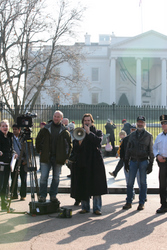 The character of “Doggart†in the film is clearly depicted as being much less intelligent than the real filmmaker (a King’s College, Cambridge graduate in the social and political sciences, and veteran director of stage and TV documentaries on both sides of the Atlantic), just as Ratray (whose acting resume includes Buzz in two “Home Alone†movies and several episodes of “Law and Orderâ€) can’t possibly be as credulous and foolish as he appears in this movie. The climax (or nadir, depending on how you look at it) of their buddy relationship occurs midway through the movie when “Doggart†tries to convince “Ratray†during a beach shoot that the narrative arc demands a nude scene. The character of “Doggart†in the film is clearly depicted as being much less intelligent than the real filmmaker (a King’s College, Cambridge graduate in the social and political sciences, and veteran director of stage and TV documentaries on both sides of the Atlantic), just as Ratray (whose acting resume includes Buzz in two “Home Alone†movies and several episodes of “Law and Orderâ€) can’t possibly be as credulous and foolish as he appears in this movie. The climax (or nadir, depending on how you look at it) of their buddy relationship occurs midway through the movie when “Doggart†tries to convince “Ratray†during a beach shoot that the narrative arc demands a nude scene.
Early on, many viewers are apt to feel an I-can’t-believe-they’re-doing-this discomfort about the romantic premise. We’re being made to watch this loser try to catch the eye of the nation’s first black female Secretary of State, who is nearly twice his age? In the course of interviewing Rice’s childhood neighbors and friends in Alabama, the filmmakers offer a very Michael Moore moment when Ratray attempts to speak to Rice’s mother as she’s trying to get from her car in the driveway to her house and pretty much brushes them off (understandably so).
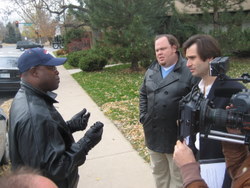 Things start to turn a little weirder – because less obviously farcical and futile – as Ratray and Doggart get Rice’s one and only ex-fiancé, former Denver Broncos receiver Rick Upchurch, to show his engagement ring and reminisce about their dates; then receive romantic advice and potential love songs from Grammy-winning composer and one-time Elvis girlfriend Carol Connors; and then put Devin through the image-making tutelage and focus-group grinder of Frank Luntz, campaign marketing wizard to a string of Republican politicians. Connors and Luntz strut their respective expertises, but they also play for the camera a little, and thereby induce a little extra vertigo in the viewer. Things start to turn a little weirder – because less obviously farcical and futile – as Ratray and Doggart get Rice’s one and only ex-fiancé, former Denver Broncos receiver Rick Upchurch, to show his engagement ring and reminisce about their dates; then receive romantic advice and potential love songs from Grammy-winning composer and one-time Elvis girlfriend Carol Connors; and then put Devin through the image-making tutelage and focus-group grinder of Frank Luntz, campaign marketing wizard to a string of Republican politicians. Connors and Luntz strut their respective expertises, but they also play for the camera a little, and thereby induce a little extra vertigo in the viewer.
–Read the rest of this entry »
|
|
|
|
| |
|
|
|
|
|
|
|
By Umut Newbury
June 15, 2009
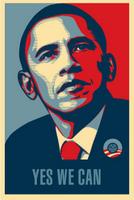 Last week, we saw an image of an American president that has been foreign to us for a little while. In Cairo, tens of thousands of Muslims cheered for President Barack Obama, as he spoke of a different world with a different United States leading it. He quoted from the three major Western religious texts and brought Egyptians to their feet with applause. As President Obama works on his second 100 days in the White House, it is a good time to take a look back and reflect on his campaign that brought him there. Last week, we saw an image of an American president that has been foreign to us for a little while. In Cairo, tens of thousands of Muslims cheered for President Barack Obama, as he spoke of a different world with a different United States leading it. He quoted from the three major Western religious texts and brought Egyptians to their feet with applause. As President Obama works on his second 100 days in the White House, it is a good time to take a look back and reflect on his campaign that brought him there.
Danny Schechter’s new documentary Barack Obama: People’s President, is a refreshing take on Obama’s campaign to the presidency. Rather than cutting and pasting coverage of talking heads telling us how Obama became the president, Schechter tries an old technique known to print journalists of yesteryear: showing it. His film opens with the famous “Yes We Can†video created by will.i.am and continues with 90 minutes of very diverse footage of the grassroots campaign that got Obama elected.
Anyone who was an official volunteer for the Obama campaign, or an unofficial volunteer (disclosure here, this reviewer was one of them) who lobbied friends, relatives, neighbors to register to vote, donate money, vote and pass on the word will enjoy seeing this big picture view of the campaign. As for those who voted and volunteered for other candidates, they would be mistaken to dismiss this film as a victory dance. People’s President lays out the steps of the Obama campaign’s success for anyone willing to learn how it was done.
The theme of Schechter’s film is the people behind the people’s candidate. Schechter’s premise is simple enough: Obama’s success lies in his campaign’s innovative use of the Internet and other new technologies, which helped lure the youth vote and reach out to many other hard-to-get constituencies. The film has footage of self-described Obama Camps across the nation, as well as an array of creativity the campaign fostered on the Internet, from will.i.am to Obama Girl and to lesser-known clips such as the “Irish Obama†and “How Obama won the KKK.†Schechter also has some experts analyzing all of this, such as NBC’s Jonathan Alter and MoveOn.org’s David Fenton. Hendrik Hertzberg of The New Yorker magazine recollects his meeting with Obama as the moment he realized that the candidate was exactly how he portrayed himself to the masses, “thoughtful, calm, disciplined, well-organized, human and strong.â€
Any campaign, Schechter argues, needs money and people. The Obama campaign got both in unforeseen amounts. Fenton says Obama won because the online tactics “broke the grip of large donors on the Democratic Party.†People like Scott Cohen describe how they felt when they heard Obama’s speech in Springfield. “I wrote the largest check of my life, for $2,300, and talked others to do so.†Cohen later had the idea to create the “An Obama Minute†video, where he asked people to give as much as they can. The first time the video aired, it raised more than $200,000.
The other strength of the Obama campaign, People’s President shows, was the superiority of its operation. The Chicago headquarters had the slogan, “No Drama with Obama.†Unlike other campaigns, there was no internal fighting, no unauthorized leaks or embarrassments. They had a tight, smooth running organization, with a simple message, “Change.†As Jonathan Alter points out, while Hillary Clinton played with different messages, the Obama campaign stuck to its original message and added a simple slogan, “Yes We Can.â€
–Read the rest of this entry »
|
|
|
|
| |
|
|
|
|
|
|
|
By Sarah Boslaugh
December 22, 2008Â
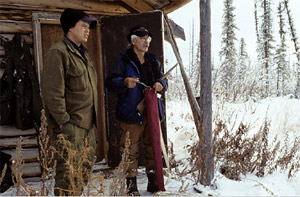 Stanley Njootli, Jr. is a young man at the crossroads: he’s charming and amiable and has a talent for art, but he also a taste for drugs and alcohol and idling his time away in bars. In his early 20’s, Stanley Jr. has already experienced homelessness, and even his drinking buddies tell him its time to go into rehab.  Stanley Njootli, Jr. is a young man at the crossroads: he’s charming and amiable and has a talent for art, but he also a taste for drugs and alcohol and idling his time away in bars. In his early 20’s, Stanley Jr. has already experienced homelessness, and even his drinking buddies tell him its time to go into rehab. Â
Stanley’s father, Stanley Njootli, Sr. has a different idea: Stanley Jr. should leave the temptations of the urban world behind and come to live with Stanley Sr. in Old Crow, a small village 80 miles north of the Arctic Circle. There’s no road access to Old Crow, and also no bars, restaurants, or movie theaters: satisfaction comes from work, family and friends, with radio broadcasts and community dances for additional entertainment. Â
Besides the absence of urban temptations, Stanley Sr. believes that if Stanley can reconnect with the traditional lifestyle of his ancestors (the First Nations Gwich’in tribe), he’ll find his identity and sense of purpose. And it will give the two a chance to reconnect as well: Stanley Sr. abandoned his wife and children almost 25 years previously, in part because he did not deal well with the temptations of the “south†(the contiguous 48 states), so father and son are virtual strangers.Â
The experiment does not begin promisingly: his first night in Old Crow (by law a dry town) Stanley Jr. goes out to party, finds a source of homebrewed alcohol, and comes home drunk. He’s not at home in his new environment, and his initial attempts at traditional skills, from managing a dog team to ice fishing with a net, do not go well.Â
But Stanley Sr. is patient and consistent, and gradually Stanley Jr. comes to appreciate a lifestyle which is very different from anything he’s known, and to take pride in his new skills. The relationship between father and son clearly grows stronger as well, although neither is given to displays of emotion or long discourses about their feelings. Stanley Sr. does articulate his beliefs on the value of the traditional lifestyle while Stanley Jr. communicates by his manner that he’s starting to agree.Â
But the stay in Old Crow wasn’t meant to be permanent, and Stanley Jr. returns to Washington State. He gets a meal at Burger King, heads to the mall and goes out drinking with friends, but concludes that it’s not as much fun as it used to be. Although Stanley Jr’s future is uncertain, he chooses to return to Old Crow at the end of the film, and his time there has clearly made him a more reflective and responsible young man.Â
Calm is the prevailing mood in Arctic Son, as if director Andrew Walton wanted to reflect the experience of the Gwich’in lifestyle in his film. Excellent cinematography by Jonathan Furmanski and Jeff Stonehouse reveals the northern landscape as spare and harshly beautiful, and Walton allows the story to unfold at a natural pace. He shows the two men slowly journeying toward an understanding which is implied more than stated, and presents it without interpolations by talking heads or voiceovers: what you see are the two Stanleys going about their daily lives and occasionally commenting on them in matter-of-fact terms. Â
The elephant in the living room is global warming, which is barely mentioned in Arctic Son. At one point Stanley Sr. notes that the temperature in Old Crow has begun to reach 80 degrees in the summer time. That’s no idle comment, because it can bring about a change in the ecosystem which could destroy the subsistence hunting and fishing culture which is the basis of the Gwich’in traditional lifestyle. It is further threatened by the proximity of Old Crow to the Arctic National Wildlife Refuge in Alaska: the continuing debate about drilling for oil in the Refuge is not just an academic discussion for the Gwich’in since it would threaten the caribou herds which form an important part of their livelihood. Â
DVD extras include a family-friendly version which bleeps out the stronger profanity, a 10-minute interview with director Andrew Walton, four additional scenes (one also in a family-friendly version), and a gallery of Stanley Jr’s artwork which, true to his description, is weird, but also shows his potential as an artist. The director’s interview includes background information about the film, including its origins: Walton met Stanley Sr. while researching a film about oil drilling in the Arctic National Wildlife Refuge, and was impressed by his intelligence and the depth of his knowledge of traditional Gwich’in culture. Stanley Sr, in turn, wanted to record traditional Gwich’in skills on film before they disappeared. Â
Arctic Son was broadcast as part of the PBS series P.O.V. and is distributed by docurama. Further information is available through their web site http://www.docurama.com/, email  ([email protected]) or by calling 1-800-314-8822.Â
—– Â
Arctic Son
docurama films
Directed by Andrew Walton
Color, 2006, 75 Minutes
|
|
|
|
| |
|
|
|
|
|
|
|
By Sarah Boslaugh
October 16, 2008
 Seldom has a film been more aptly titled than Saving Marriage, a new documentary by Mike Roth and John Henning which traces the political course of same-sex marriage in Massachusetts from November 2003 through June 2007. The film presents a diversity of voices, both for and against same-sex marriage, and makes one point crystal clear: people on both sides of this issue believe they are, in fact, saving marriage. Â Seldom has a film been more aptly titled than Saving Marriage, a new documentary by Mike Roth and John Henning which traces the political course of same-sex marriage in Massachusetts from November 2003 through June 2007. The film presents a diversity of voices, both for and against same-sex marriage, and makes one point crystal clear: people on both sides of this issue believe they are, in fact, saving marriage. Â
No wonder tempers run high. On the one hand the film includes people such as Mitt Romney (governor of Massachusetts, 2003-2007) who states his belief that “marriage is a special institution between a man and a woman†and Kris Mineau of the Massachusetts Family Institute, who says he believes that “Same sex marriage degrades the value of my marriage. It says to me that my uniqueness as a man, as a father and as a husband is irrelevant.†For both men, traditional marriage is part of their identity as well as a fundamental institution which they feel is crucial to American civil society.Â
On the other hand, Saving Marriage interviews many gay and lesbian people who feel they are denied both the legal protections and the cultural significance of marriage, for no reason other than prejudice against their sexual preference. The cultural significance is not to be minimized: as activist Amy Hunt puts it, you grow up seeing your relatives and friends get married and it’s the most important day of their life, and then you realize that “you can’t have the most important day in your life†because the law doesn’t recognize your relationship with your partner. Neither are the legal protections: one gay man interviewed for the film relates a terrifying experience in which his child (co-parented with his male partner) was seriously ill and when he tried to learn more about the child’s condition a nurse seemed mainly interested in interrogating him about his relationship to the child (which did not fit into any legally-recognized category). Â
Saving Marriage presents its story chronologically, alternating between the progress of same-sex marriage through the courts and legislature and personal stories of how members of the gay and lesbian community were changed by the court’s decision. The story begins on November 18, 2003, when the Supreme Judicial Court of Massachusetts ruled in Goodridge v. Department of Public Health that excluding same-sex couples from the right to marry was unconstitutional. Governor Mitt Romney ordered that marriage licenses be issued to same-sex couples beginning May 17, 2004, and gay and lesbian couples all over the state began shopping for rings and planning their vows. Lest anyone doubt the eagerness of gay and lesbian couples to marry, on the night of May 16, many couples lined up at Boston City Hall so they could apply for a marriage license immediately after midnight. Roth and Henning are there with their cameras, documenting the happy couples applying for their marriage licenses, and some of the subsequent marriages as well.Â
However, those opposing gay marriage also launched into action “about one nanosecond†after the Supreme Court decision, according to one of the lesbian activists interviewed in Saving Marriage. The opposition was successful in communicating their displeasure to the state legislature, which in March 2004 voted to allow the public the right to vote on a constitutional amendment which would override the Supreme Court decision and ban same-sex marriage in Massachusetts. This effort was often couched in phrases such as “let the people decide†although, as one of the gay activists points out, matters of civil rights are not customarily left up to a popular decision. What if some of “the people†wanted to ban people of different races from marrying: would that be an appropriate matter to place on a general election ballot? And if it passed, would such marriages be banned?Â
Nothing is simple in American politics, and one of the best features of Saving Marriage is the way it maintains focus and a sense of chronology while also relating the complexities of the legal status of same-sex marriage: it was not just won once, but won, threatened, saved, threatened, and saved again. Conveying this complexity is crucial because few things are as exasperating to an outsider as the American political system, which at times seems to have been devised by Rube Goldberg for the purpose of discouraging the uninitiated from even trying to understand the process. And in the gay and lesbian community, politics hasn’t always been considered the coolest way to spend your time: as gay activist Josh Friedes puts it, as a gay man he expected to spend his time “looking for Mr. Right instead of fighting for the right to marry Mr. Right.†Â
–Read the rest of this entry »
|
|
|
|
| |
|
|
|
|
|
|
|
By Bryan Newbury
October 12, 2008Â
“Human history becomes more and more a race between education and catastrophe.â€
H.G. Wells
Â
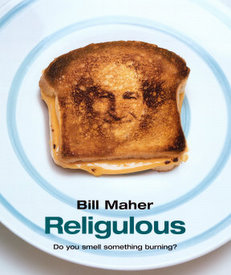 There seems to be a drumbeat. Through the ages, battles of ideas and territory (and, of course, acquisition of resources, which always brings about ideas on why someone wrongfully holds territory) have raged, to the point that it would seem to most observers that conflict and usurpation are simply part and parcel of the human condition. In the 20th Century, the model was that of the Cold War, where, as Ed Abbey put it succinctly, “In the Soviet Union, government controls industry. In the United States, industry controls government. That is the principal structural difference between the two great oligarchies of our time.†In 19th Century America, it was over the scourge of slavery, or, if you prefer, a clash between an outmoded agrarian culture and a new industrialized one. In the 18th, to venture further into a sort of romantic oversimplification, there was the battle between monarchy and representative governance. And on through the centuries, even back to the sieges of Lisbon, Jerusalem, Istanbul, et cetera.  There seems to be a drumbeat. Through the ages, battles of ideas and territory (and, of course, acquisition of resources, which always brings about ideas on why someone wrongfully holds territory) have raged, to the point that it would seem to most observers that conflict and usurpation are simply part and parcel of the human condition. In the 20th Century, the model was that of the Cold War, where, as Ed Abbey put it succinctly, “In the Soviet Union, government controls industry. In the United States, industry controls government. That is the principal structural difference between the two great oligarchies of our time.†In 19th Century America, it was over the scourge of slavery, or, if you prefer, a clash between an outmoded agrarian culture and a new industrialized one. In the 18th, to venture further into a sort of romantic oversimplification, there was the battle between monarchy and representative governance. And on through the centuries, even back to the sieges of Lisbon, Jerusalem, Istanbul, et cetera. Â
The drumbeat that Religulous continues, building on the rhythms of Dawkins, Hitchens and Harris, might be summed up thusly: Welcome to the New Dark Age. For the more hopeful, it could be tweaked to read “Let’s get a handle on this thing, or we’re looking squarely into the New Dark Age.†As Bill Maher inveighs against the reckless stupidity, arrogance and danger of religion in our time with rapier wit and a type of infectious charm, there is no secret that the thesis behind this comedy is no laughing matter. In fact, he sees the problem as important enough to eventually say it flat out. If those who value rational thought don’t begin to stand up to those of fundamentalist persuasions, we are courting disaster. The 21st Century will not be defined by American economic power versus a rising China, nor by a battle the world over for depleting resources, but by a final battle, pardoning the revelatory tone of such a phrase, between secular and scriptural.Â
When one examines the last couple of decades, the pieces seem to fit. They seem to paint a picture that makes a compelling case for what would have seemed hysterical posturing. Even a few years ago, the concept of our time being defined by a tussle between faith and reason would raise nearly every eyebrow in the room. As political theology morphs and advances, as it becomes more sophisticated and savvy the world over, it becomes very hard to dispute the core statement of Religulous, that just such a battle will indeed define or devour us all. Â
Maher’s grand statement is a must-see if only for timeliness and as a companion volume to the aforementioned authors on the subject. It certainly doesn’t hurt that the film is also brilliantly written, sleek in production, direct and coherent in narrative and simply hilarious. Â
–Read the rest of this entry »
|
|
|
|
| |
|
|
|
|
|
|
|
By Bryan Newbury
September 16, 2008
“You could have presented yourself as being self-taught, the product of your own worthy efforts, there’s nothing to be ashamed of, society in the past took pride in its autodidacts, No longer, progress has come along and put an end to all of that, now the self-taught are frowned upon, only those who write entertaining verses and stories are entitled to be and go on being autodidacts, lucky for them, but as for me, I must confess that I never had any talent for literary creation, Become a philosopher, man, You have a keen sense of humour, Sir, with a distinct flair for irony, and I ask myself how you ever came to devote yourself to history, serious and profound science as it is, I’m only ironic in real life, It has always struck me that history is not real life, literature, yes, and nothing else, But history was real life at the time when it could not yet be called history, Sir, are you sure, Truly, you are a walking interrogation and disbelief endowed with arms…â€
José Saramago, The History of the Siege of Lisbon
(Giovanni Pontiero, translator.)
 Astra Taylor’s Zizek!, like the film’s namesake, provides a challenge to the reviewer in a way many ostensibly similar films – think You Can’t Be Neutral on a Moving Train and Manufacturing Consent – do not. There are quite a few reasons for this: brevity of run time; the difference between “activist†theoreticians, historians and philosophers like Zinn and Chomsky and the more urbane and inactivist bloke that Zizek personifies; the rarified air of Lacanian psychoanalysis versus the relative simplicity and utility of pure social science. In a sense, to wax postmodernist, the reviewer is burdened with the same role as the director. The observer is inside, aiming to describe a description, or depiction, that was the implicit purpose of the film itself. Astra Taylor’s Zizek!, like the film’s namesake, provides a challenge to the reviewer in a way many ostensibly similar films – think You Can’t Be Neutral on a Moving Train and Manufacturing Consent – do not. There are quite a few reasons for this: brevity of run time; the difference between “activist†theoreticians, historians and philosophers like Zinn and Chomsky and the more urbane and inactivist bloke that Zizek personifies; the rarified air of Lacanian psychoanalysis versus the relative simplicity and utility of pure social science. In a sense, to wax postmodernist, the reviewer is burdened with the same role as the director. The observer is inside, aiming to describe a description, or depiction, that was the implicit purpose of the film itself.
This is a conundrum above the reviewer’s pay grade, unless he is arrogant enough to presume he can cut through to the marrow of Zizek’s unity within paradox within unity, or perfidious enough to claim to have read the source texts so beautifully displayed by Molly Schwartz’s animation. How to attack it, then?
In a state of deep contemplation, this reviewer considered the José Raimundo Silva option, to say, emphatically and unironically, that Slavoj Zizek does not embrace a Lacanian-Marxist hybrid, that he did not call himself a monster, that the viewer does not question whether paradox is unity and chaos order. This brief flirtation with critical liberation was snuffed out precisely because it begged all of the mendacity and conceit mentioned above.
The only way to view Zizek! is the most direct one: what is Taylor seeking to accomplish and how entertaining and thought provoking were here efforts?
The first question requires a certain presumptuousness. Having been duly acquitted of fraud and deception, the reviewer can expect some latitude in this direction. It would be fair to say that the goal is an introduction to Mr. Zizek and his outlook. If it were an overture to cultural theory wonks and professional academics, it would be lacking. Nothing in the presentation of the film suggests such soft failures. If the presumption is correct, then Taylor has certainly achieved her goal. Through a series of interviews, brief clips from lectures spanning from Buenos Aires to Boston, and artfully portrayed texts central to the disjointed unity of Zizek’s approach to, for lack of a more precise term, philosophy, the viewer is instantly gripped by the larger than life yet knowingly insignificant character Zizek cuts. There are bits and pieces, a successful introduction to just who the man is and what, at the surface, he thinks and why, just enough to cajole the viewer into further examining his works. It would be less presumptuous to posit that the person buying this film from the website of her choice would be wise to go ahead and employ the “people who bought this also…†option.
As to the second, Taylor and team couldn’t have done better. The shooting and editing subtly frame the film in a way that we might imagine Zizek appreciating. From the very beginning, with a short statement on creation, chaos, void and love, to the imaginatively sequenced subsections of the film (one of which has the humorous linguistic breakdown “PSYCO/ANAL/YSISâ€), there is a harmony of presentation of a harmony of thought. The most impressive ingredient in the presentation is the work of Ms. Schwartz, who alights upon biographical snippets, bits of text and elegant yet enigmatic cultural theorizing with an aplomb that must make her quite sought after in her discipline. Her ability to illustrate complex concepts with a combination of aesthetic grace and edifying simplicity take the film up a few levels. Again, the documentary succeeds in artfully and entertainingly embracing its subject.
Zizek! does not look to be designed for group viewing or post-film (dare we say postfilm?) discussion among more than a roomful of people. Whether a film could present a more complete characterization of Zizek or his works in three hours, let alone one, is debatable. (The reviewer leans more to the contrary position on this question, and thankfully there is a wealth of extras on the DVD to soften the blow of the shockingly abrupt end leaving the viewer engaged in an Armageddon of the Ego, or possibly just politely asking for a bit more footage.) As an introduction, and an effective way to entice people into poring over Slavoj Zizek’s punctilious planet of paradoxes, Zizek! comes up roses.
Which would bring us to what roses actually are…
—–
Zizek!
Directed by Astra Taylor
Color, 2005, 71 minutes
English and Slovene with English subtitles
Zeitgiest Films
|
|
|
|
| |
|
|
|
|
|
|
|
By Umut Newbury
August 7, 2008
“To me it’s so simple that life should be lived on the edge of life. You have to exercise in rebellion, to refuse to taper yourself to rules, to refuse your own success, to refuse to repeat yourself to see every day, every year, every idea as a true challenge and then you are going to live your life on a tight rope.” -Philippe Petit
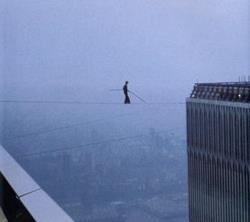 Life, death, dreams and rebellion… The French have always been extraordinarily talented in defying the mainstream Western cultures’ accepted notions on these. The last time the French were truly successful at jarring our sense of what is good – life, what is evil – human mortality, was done through New Wave cinema with the likes of Jean Luc Godard and Francois Truffaut. Life, death, dreams and rebellion… The French have always been extraordinarily talented in defying the mainstream Western cultures’ accepted notions on these. The last time the French were truly successful at jarring our sense of what is good – life, what is evil – human mortality, was done through New Wave cinema with the likes of Jean Luc Godard and Francois Truffaut.
James Marsh’s new documentary, Man on Wire, combines the best of that era: Godard’s Breathless, and Truffaut’s 400 Blows, with a touch of Camus. For the post-911 world inhabitant, it is a foreign time, where breaking into buildings, i.e. the World Trade Center towers, and mocking death was an act of art, not an act of terrorism.
The subject of Marsh’s masterpiece, Philippe Petit, is not your typical Frenchman, just smoking cigarettes and drinking Bordeaux and cursing the meaninglessness of life at a sidewalk cafe. He is a reckless high-wire walker taunting death on a daily basis. His goal: To walk on a wire suspended between the North and South towers of the World Trade Centers shortly after they are built in 1974.
“My story is a fairy tale,†Petit begins rather innocuously. He was a little boy with a passion for climbing things, anything: “Why, I’ll let the psychiatrists to figure out the reasons. To escape things, to see things from a different perspective.†Well, the little French boy gets a toothache someday and is sitting in a dentist’s office looking at magazines. He sees a picture of these two towers (the French media cleverly juxtaposed the Eiffel Tower in front of them to show how magnanimous they would be when they were built) and is smitten instantly. He rips the picture out of the magazine and carries it with him: “Usually, when you have a dream, it’s there, tangible. The object of my dream doesn’t even exist yet.â€
The film doesn’t quite explain how Petit grows up to have the luxury of just walking on wires in his backyard and dreaming of scaling large, prominent buildings, and it really doesn’t have to. This story originates in France, after all, and we must start with a romance. Petit pursues a shy 20-year-old, Annie Allix, and she immediately becomes his number one fan and supporter of reckless acts. By 1971, Petit gets his first grandiose idea: To walk on a wire between the towers of the Notre Dame Cathedral. He sees it not as trespassing on the holy, rather describes himself as “a poet conquering beautiful stages.†The footage is simply breathtaking, even for those who have never been a fan of circus acts. There is a deep philosophical sense about Petit’s act. Somehow, it is not about the ridiculousness of a young man risking his life publicly. He is making a statement.
Two years later, in June of 1973, Petit, Allix and Petit’s other, nonsexual cohorts, repeat the act at the Sydney Harbour Bridge. Again, it is a magnificent scene. The whole bay of Sydney stretched out below a lunatic, while regular folks are communing to work, provides an immensely ironic perspective. When he gets arrested, Petit is still playing around, managing to swipe the watch of a Sydney policeman. The viewer would think this is a child who does not understand the consequences of his actions. But he does. “The fact that high-wire activity is framed by death is great,†Petit says. “You have to take it seriously.†With every potentially fatal act, Petit seems to be saying, “I understand life. I understand death in a way you will never know.â€
After the Notre Dame Cathedral and the Sydney Harbour Bridge, where does the high-wire walker take his act? Of course, he could have chosen any of a number of well-known European or Asian sites, however, this was all a means to an end – The World Trade Center towers. “The two towers galloping in my head, as I return to Paris, the towers were almost built,†Petit recalls. His girlfriend Allix admits to having limits to her undying support. “When he showed me the pictures, I was afraid. It’s inhuman to want to go up 450 meters in the air and walk. This was demonic, I wanted to say, ‘Stop.’†But she doesn’t. Neither do his buddies, Jean Louis Blandeau or Jean Francois Heckel. Heckel says about the Notre Dame project, “It was against the law, but not wicked or mean. It was wonderful.†So when approached about the World Trade Center project, Heckel is in. So is Blandeau, after receiving a postcard from New York. He looks at the towers on the front of the card, with a line drawn between them. “I thought, of course, that’s why they are there.â€
Blandeau is the voice of reason in the group, immediately realizing that there is no way to accomplish Petit’s crazy dream legally. No one is going to authorize such a wildly risky, childish dream. Once again, this will be a covert operation. Petit’s small group of outlaws soon grow, with an Australian, a couple of stoner Americans, and even an inside man from the WTC. To some, it is “a fun adventure,†others admit that they have been drawn to things, “that are not totally legal.â€
The team travels back and forth between New York and France. They spy on the World Trade Center towers, disguise themselves to get information, set up a “training camp†in a meadow in France. By all modern classifications, they must be terrorists. The day of the act, affectionately nicknamed “Le Coup†by Petit, they sneak in the buildings with fake IDs. Everybody is terrified, everyone is convinced they will get busted and end up in jail or deported. But after more than 12 hours, in the early morning hours of Aug. 7, 1974, Petit manages to get on his wire between WTC North and South towers. He walks back and forth for 45 minutes, making the crossing eight times. Sgt. Charles Daniels, one of the two Port Authority police officers on the scene describes him as a “tight rope dancer because you couldn’t call him a walker.†Petit keeps walking back and forth smiling at the police, taunting them, only agreeing to step off after being told that he will be plucked by a helicopter. Everyone, including the authorities, is mesmerized. “I personally thought I was seeing something I would never see again, once in a lifetime thing,†Daniels tells the local press.
The footage of this crazy little Frenchman kneeling on a wire in between the two World Trade Centers is one of the most haunting images one will ever see on the big screen. The images of Petit on top of the Notre Dame Cathedral and the bridge in Sydney are powerful, too, but because of our collective history in the 21st century, it becomes something else. It makes the viewer wonder what happened to us as a human race. When did we get from that to this in less than 30 years? But perhaps, it is best to not think of this film in the context of recent history at all and to stick with Petit’s philosophy, “Why? There is no why.†Modern life is both beautiful and terrifying, and we’d be better off just accepting that. Man on Wire will help anyone come to terms with the absurdity of our existence on this planet.
—–
Man on Wire
Directed by James Marsh
2008 Magnolia Pictures
94 minutes
|
|
|
|
| |
|
|
|
|
|
|
|
By Umut Newbury
August 6, 2008
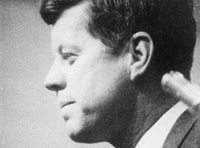 Less than three months from a historic presidential election comes an extremely timely documentary from Docurama Films. The Robert Drew Kennedy Films Collection, including Primary, filmed in 1960, Crisis, filmed in 1963, and Faces of November, filmed in 1964, is a crucial trilogy for students of history and political junkies everywhere. Less than three months from a historic presidential election comes an extremely timely documentary from Docurama Films. The Robert Drew Kennedy Films Collection, including Primary, filmed in 1960, Crisis, filmed in 1963, and Faces of November, filmed in 1964, is a crucial trilogy for students of history and political junkies everywhere.Â
History repeats itself and the resemblances of this year’s presidential race, or more accurately, of one candidate, Sen. Barack Obama, to the Kennedys, both JFK and RFK, have already been underscored earlier in the year. Primary only makes this more evident, as it follows John F. Kennedy and Hubert Humphrey during the Wisconsin primary election. The similarities are eerie. Humphrey talks to farmers and older folks. Though he has a populist message similar to that of John Edwards in this year’s campaign, the size of his crowds resembles more that of John McCain’s. Then we see images of Kennedy that are all too familiar: Large crowds, mostly young people, mostly young girls, cheering, running down the streets to meet the candidate. Just like with Obama, JFK as a candidate is more like a celebrity; everybody wants to shake his hand, everybody wants an autograph. Humphrey tells the farm folk, “Fortune and Life magazine don’t give a hoot about your life,†in an effort to undermine JFK’s celebrity status. Isn’t that what John McCain was echoing when he ran the recent attack ad “Celeb,†asking the question about Obama, “Sure, he is a celebrity, but is he ready to lead?â€
Kennedy’s strength in Wisconsin, as Primary shows, is in the heavily populated areas, mostly the big cities. Fast-forward to 2008, Obama’s strengths are the same. Then, of course, there are shots of the first great First Lady, Jackie Kennedy. She is quiet and graceful, the symbol of the good, supportive wife of the 1950s and 1960s, much like the character Betty Draper in AMC’s Mad Men. The viewer cannot help but think of Michelle Obama. If only Mrs. Obama stayed quiet and doting like Jackie Kennedy, she would be beloved as well. But this is 2008 and Mrs. Obama is the symbol of the 21st century wife: strong, independent, smart, but never timid.Â
Primary’s closing shots are from the campaign headquarters where we see JFK chain-smoking his H. Upmann petite cigars and admitting that he did indeed tell a reporter, “if lost here, I’d find it extremely difficult to be nominated.†Luckily for him, the newspapers never had a chance to use that line against him to get him to drop out of the race. As Humphrey leaves his headquarters quietly at the end of the evening, it is evident the candidate from the neighboring Minnesota has lost the election to the “Catholic elitist from the East.â€
As fascinating as Primary is with the déjà vu moments, the next film of the historic three-film collection simply blows it out of the water. Crisis: Behind a Presidential Commitment has some of the most incredible behind the scenes White House footage ever seen on film. The footage starts on June 10, 1963, the day before the first two African-American students, Vivian Malone and James Hood, would try to enroll for summer classes at the University of Alabama. Alabama is the last state in the nation to allow integration and the state’s infamous Governor George Wallace threatens to stand between the students and their education.
–Read the rest of this entry »
|
|
|
|
| |
|
|
|
|
|
|
|
The IFC has a great opportunity for individuals with documentaries ideas. If you have a good concept for a documentary and want to get funding for it or get it seen by decision makers, you need to check out the IFC The Back to Basics Documentary Challenge.
You are only required to submit three minutes of video with your idea for the film, but the deadline is fast approaching (August 3, 2008), so you need to get organized quickly.
IFC is looking for a short documentary or a documentary trailer. It must be a non-fiction with the subject matter of your choosing. Please note, for this contest, IFC is only accepting documentary concepts. Film submissions will be judged on the filmmakers ability to portray their unique point of view with their chosen subject matter as well as the film’s overall creative and technical production merits.
Two cash prizes are being offered:Â 1st prize is $7500, Runner-up prize is $2500.
To get signed up and upload submissions, visit www.ifc.com/backtobasicsÂ
Documentary Films .Net receives emails frequently from individuals with ideas for a film, but no idea how to take the next step. This is the next step. Use your video to pitch the idea you have always had.
Go to the IFC challenge webiste here www.ifc.com/backtobasics. Opportunities to just pitch ideas are very limited. This challenge is your opportunity.
|
|
|
|
| |
|
|
|
|
|
|
|
By Bryan Newbury
July 2, 2008
“Time is running out for Tibet. Every day, while we are sitting here praying for world peace, inside Tibet there’s more and more and more… and more… Chinese moving in. And, as I see it, the Chinese are playing for time… and we’re playing into their hands.â€
Lhasang Tsering, Pro-Independence Tibetan in Exile.
Proposed diegesis:
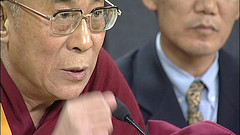 08.08.08. The Olympic Torch has arrived in Beijing, give or take a few hundred human rights related expulsions on the way, and the grand flame is alight in the cauldron. Without warning, an international event ensues. The countries involved immediately scramble into action mode. For the United States, it could be a further incursion into the Near East. For Germany or France, a retribution through immigration reforms. For any number of countries, any number of scenarios. 08.08.08. The Olympic Torch has arrived in Beijing, give or take a few hundred human rights related expulsions on the way, and the grand flame is alight in the cauldron. Without warning, an international event ensues. The countries involved immediately scramble into action mode. For the United States, it could be a further incursion into the Near East. For Germany or France, a retribution through immigration reforms. For any number of countries, any number of scenarios.Â
What of the host country, then? In the paranoiac surveillance state of China, there are a hundred ways to spin the event. Whatever the case of the victim country, China can surely parlay the unfortunate event into additional repression of a chosen group. The smart money may very well be on the largely ignored Uyghur dissidents in Xinjiang province. Why not? They are Muslim, as the assailants will no doubt be, and there are no celebrities to rally on their behalf. Then again, the Tibetans have long been the face with which China’s Orwellian boot has sought to step on eternally. Again, what would stop them, provided they share the requisite intelligence on the criminals in this hypothetical situation?
If The Unwinking Gaze is any indication, it wouldn’t be His Holiness, The Dalai Lama.Â
It is difficult to wrap one’s mind around the Tibet situation. Aside from the vocal, well-meaning… and, likely, misguided… activists in the west – with their “Free Tibet†stickers and catchy chants in tow – any outside observer must confess an embarrassing inability to appreciate the nuance His Holiness is obliged to deal with.
Joshua Dugdale is to be commended for presentation. The film presents The Dalai Lama as he is; or, at least, as he is within the parameters of cameras and microphones. Following a brief introduction, we are given His Holiness and his supplicants without voiceover. Restrained narration is often a demerit in documentary filmmaking. In the case of The Unwinking Gaze, the viewer is rewarded greatly. Whatever frustration might arise from a seeming lack of context is subsequently acquitted in the conversation it elicits.Â
A possible point of debate would be The Dalai Lama’s politic nature. From one perspective, it would appear to be callous, the proclamations of a false prophet. When listening to Tsering or the Tibetan Youth Congress quite literally shouting from rooftops, the long view of His Holiness – secure in his Dharamsala castle – it is forgivable for the viewer to share a profound consternation with the patient “Middle Way.†On the other hand, what would you have him, or his countrymen, do? As he points out, to the Chinese, the loss of 100,000 is nothing. To the Tibetans, the loss of 100 is substantial. “What of Castro, the Granma, and Ernesto Guevara?†the response comes, “Or Mao, for Chrissakes? Would the Tibetans not be served better by their own Mao, rather than this ineffectual holy man?†Whatever victory could be expected, the other side will respond, would redefine Pyrrhic.Â
Back and forth it goes, like the recently minted Olympic sport of table tennis. “The Tibetan leadership in exile seeks to retain only the linguistic, cultural and religious elements of society, happy to consign its brethren to slavery. What’s that, then? As long as they retain primitive control, they capitulate to the very modern Chinese concept of Market Stalinism?†“Would you have the Lamas and the Ayatollahs equated?†comes the reply. And on and on.
This is the magic within The Unwinking Gaze. To the detached viewer, it is anything but a naïve hosanna to His Holiness. There are fifty questions for every answer, which, in this case, is the best we can expect. The Dalai Lama may well qualify for sainthood. An argument exists for his being all too human. What better praise of a filmmaker than to say that he puts this complexity at our door?Â
—–
The Unwinking Gaze: The Inside Story of the Dalai Lama’s Struggle for Tibet
Produced & Directed by Joshua Dugdale
Color, 69 minutes, 2008
|
|
|
|
| |
|
|
|
|
|
|
|
By Joshua Davis
June 15, 2008
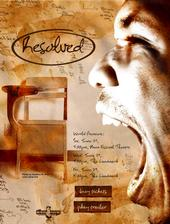 The scene is high school students looking unusually confident and serious. Young people any instructor would be happy to have in a classroom setting. Some jargon is used, but most viewers will see nothing out of the ordinary. Then the speeches begin, and all hell breaks lose. These kids are speaking at speeds so fast that very little is understood. If you were in the room with them, you would have little reason to stay longer than a few minutes. Something must be wrong. Are the judges going to leave the room in disgust? Certainly this can not be normal; did these kids take an overdose of an often prescribed drug to address ADD?  Weird. Alien. Pointless. Why? The scene is high school students looking unusually confident and serious. Young people any instructor would be happy to have in a classroom setting. Some jargon is used, but most viewers will see nothing out of the ordinary. Then the speeches begin, and all hell breaks lose. These kids are speaking at speeds so fast that very little is understood. If you were in the room with them, you would have little reason to stay longer than a few minutes. Something must be wrong. Are the judges going to leave the room in disgust? Certainly this can not be normal; did these kids take an overdose of an often prescribed drug to address ADD?  Weird. Alien. Pointless. Why?
This is the opening of the movie Resolved. Up until this point it would seem obvious that debates should be easy to film. In national politics, they are often televised and have served as a way to document key parts of political history. But after jolting the viewer with the opening, the narrator explains that the highest level of high school policy debate started to take a turn in the 1960s to what is called “spread†(SPeed-READing). Spread involves speaking rapidly in order to get out as many arguments as possible. One debater started speaking faster and others just kept increasing their pace until nearly all debaters at the highest level were speaking at a rate of 300 to 400 words-per-minute. The speed at which the debaters speak does not make for comfortable observation. The film explains that since spread became the norm, only those who have participated in or coached debate can now effectively follow the debates.
Despite this potentially barrier, the filmmakers were still able to create a compelling film that is well balanced between explaining the competition that is debate and how the lives of the debaters affect their approach to the activity and its potentially exclusive nature. Â
–Read the rest of this entry »
|
|
|
|
| |
|
|
|
|
|
|
|
By Bryan Newbury
June 11, 2008
 Just a day after clinching the Democratic nomination for the presidency, Senator Barack Obama received helpful words from his erstwhile (so Democrats hope) adversary, Senator Hillary Clinton. It was at an AIPAC (American Israel Public Affairs Committee) convention, where she assured the audience that Obama would be a friend to Israel. The elephant sitting at table three could have pointed out that this goes without saying. In the United States, support for Israel is a requirement, whether running for state senate, the House of Representatives, or county clerk, let alone president. Just a day after clinching the Democratic nomination for the presidency, Senator Barack Obama received helpful words from his erstwhile (so Democrats hope) adversary, Senator Hillary Clinton. It was at an AIPAC (American Israel Public Affairs Committee) convention, where she assured the audience that Obama would be a friend to Israel. The elephant sitting at table three could have pointed out that this goes without saying. In the United States, support for Israel is a requirement, whether running for state senate, the House of Representatives, or county clerk, let alone president.
It is understood by anyone who even casually follows politics, yet it retains elephant in the room status. This is one of the many “whys†regarding the influence of the Israel lobby, one that – like most of the others – will likely never be discussed in our media, and certainly not in our legislature.Â
Dutch public broadcaster VPRO presents a balanced and knowledgeable look at the question, and it is vexing to contemplate why our PBS avoids the issue. As with so many things dealing with Israel or the Jewish Diaspora, it is tricky footing for any commentator. The dual nature of the Jewish people, that Janus face of perseverance and victimhood, opens any interrogation to a host of charges, along with observations that can tread easily into the realm of conspiracy theory. The deftest minds of the ages have fallen prey, and the current state of affairs hardly makes it any easier. Thus, the host of “whys,†such as: Why does the United States give more money to Israel than any other nation, though it is a comparatively wealthy nation state?; Why do we consistently veto any United Nations resolution that is infinitesimally critical of Israeli policy or action?; Why is it that the truism, as stated by Eric Hobsbawm, that “(t)he default position of any state is to pursue its interests,†seems to belie our relationship to this small Near Eastern nation?; fall into a dead zone of inquiry here.Â
It would be simple to dismiss these questions, and others, as the stuff of conspiracy theory… as wild-eyed Anti-Semitic claptrap… were it not for the fact that a documentary such as this is virtually impossible to make or distribute in the United States. The findings and opinions contained therein would be rightly condemned as Illuminatiesque soothsaying, were it not for the palpable intimidation and atmosphere of silence cultivated by allies of the Israel lobby, the same kind of silencing that serves as primordial breeding ground for over-reaches and conspiracies. The only cure for hatred and darkness, to paraphrase Dr. Martin Luther King, is love and light.
Just why these tactics are employed, in academia, international affairs, and even domestic issues, isn’t addressed directly by the film, nor is it the subject. In quite objective fashion, The Israel Lobby chooses to poke the elephant by pointing out that these tactics do exist, and that the aforementioned groups are subject to the sort of chilling effect that they portend.
–Read the rest of this entry »
|
|
|
|
| |
|
|
|
|
|
|
|
A Reaction, by Bryan Newbury
June 2, 2008
http://www.theonion.com/content/video/diebold_accidentally_leaks
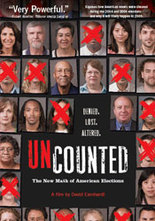 You might have seen a satirical Onion video this February about Diebold accidentally leaking the 2008 general election results. You might have laughed. You might have stopped to consider the likelihood of this fake news piece being, in many ways, more efficacious than hours of election coverage on mainstream networks. The laughter might have subsided when the realization hit. You might have seen a satirical Onion video this February about Diebold accidentally leaking the 2008 general election results. You might have laughed. You might have stopped to consider the likelihood of this fake news piece being, in many ways, more efficacious than hours of election coverage on mainstream networks. The laughter might have subsided when the realization hit.
For those of you who did indeed experience that, Uncounted will serve as a thought-provoking sermon to a convert. For those of you that might have, but haven’t seen it as yet, click the link. We’ll wait.
All right. Now, for everyone left outside of groups A and B (which one can only suppose fall into the ostrich camp, the third congressional district of Oklahoma, or the mainstream media), the film should serve as a wake-up call. It’s tough out there, but you’ve been hitting the snooze button for about a decade. While you were sleeping, we might have lost our democracy.
Uncounted, much like Hacking Democracy, is information dense and utterly shocking, if a bit uneven in strictly aesthetic terms. In the course of a short 81 minutes, David Earnhardt addresses the principle issues driving successful election fraud. We start, naturally, in Ohio, circa 2004. One can almost feel the tingling, as the ghosts of strongmen and box stuffers throughout the ages, from Chicago to New Orleans and beyond, simultaneously quiver with admiration and kick themselves with envy while witnessing the myriad of methods used to attain scandalous levels of voter disenfranchisement. Uncounted illustrates the oppressively long lines, the purging of voter rolls, the undervotes (more on this to follow), and, of course, the voting machines. This reviewer can relate on the latter only through the words of the eternal Viv Savage: “Quite exciting, this computer magic.â€
–Read the rest of this entry »
|
|
|
|
| |
|
|
|
|
|
|
|
The Documentary Films .Net site has never been casually used to help raise funds for charity. However in the last year members of our staff have have had the pleasure of meeting a great couple who are both dealing with cancer while raising their young son. At the moment, neither of their cancers are life threatening, but they and millions of others struggle with cancer’s affects every day. Both are involved in the American Cancer Society’s Relay For Life event, so the publishers of the site felt it would be an event worthy of bringing to the attention of our readers.
Josh Davis, this site’s publisher will be walking at the Lawrence, Kansas Relay For Life held at the Free State High School track. The event will be held overnight starting in the evening on June 13th. Teammates will be walking throughout the night to raise awareness and funds to fight cancer.
If you are interested in donating, you can do it online via credit card directly to the American Cancer Society. Donations can be accompanied by a note honoring someone you know who has been touched by cancer.
A link to my event webpage is provided below.
http://main.acsevents.org/site/TR/RelayForLife/RelayForLifeHighPlainsDivision?pg=personal&fr_id=5537&fr_id=5537&px=6458351
Any donation no matter how small is appreciated.
|
|
|
|
| |
|
|
|
|
|
|
|
By Phillip A. Pell
May 21, 2008
It’s fashionable to add “the Musical” to the end of things these days.
From “Cannibal: the Musical” to “My Hammer, My Friend: the Musical” the
tag line is intended to convey a snide, ironic sneer about the subject
matter; a blase disregard for what otherwise could be considered a
subject ill-suited to the frivolous treatment musical theater normally
conveys. From the title alone it would be very easy to write off
“Autism: the Musical” as just another offensive example in this same,
tired vein. This hasty rush to judgment could not be farther from the
truth.
The film starts out with a set of statistics from the Centers for
Disease Control. In 1980 fewer than 1 in 10,000 children was diagnosed
with autism. Now it’s 1 in 150. The filmmakers apparently want to lead
the viewer to the conclusion that autism is on the rise at more than
epidemic proportions however it is just as easy to draw the conclusion
that we’re getting better at understanding who is autistic and
diagnosing disorders farther up the autism spectrum. Watching the film
you’ll probably recognize the mannerisms of “that weird kid” you avoided
or bullied in grade school. You just wrote him off as a spaz or a nerd.
You probably gave him a wedgie or kicked him down the stairs. From the
first frames of this film it’s hard to avoid the realization that this
is a film less about a bunch of autistic kids making a musical than it
is a less-than-subtle indictment of society, schools, medical
institutions, parents and you personally. The autistic kids are a red
herring; an obvious attention-grabber that sets you up for the kick to
the gut realizations that come later.
–Read the rest of this entry »
|
|
|
|
| |
|
|
|
|
|
|
|
By Bryan Newbury
April 28, 2008
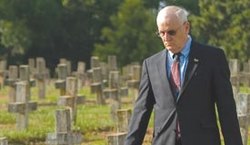 A person’s views on the death penalty don’t just change. They evolve. When someone takes the time to investigate the process and the punishment, the only intelligent conclusion he can arrive at is that capital punishment is a barbaric miscarriage of justice. This seems to be the case At the Death House Door puts forward, and it would be difficult to argue to the contrary. A person’s views on the death penalty don’t just change. They evolve. When someone takes the time to investigate the process and the punishment, the only intelligent conclusion he can arrive at is that capital punishment is a barbaric miscarriage of justice. This seems to be the case At the Death House Door puts forward, and it would be difficult to argue to the contrary.
Most who maintain a fervently anti-death penalty stance have a Road to Damascus moment in which the act of a state killing in order to discourage killing unravels before them. For some, it was the case of Roger Keith Coleman of Grundy, Virginia. In 1992, Coleman became a cause célébre. All the pieces seemed to fall into place. Here was a coal miner who seemed to have had to complete a decathlonesque performance en route to the rape and murder of his sister-in-law. Key evidence seemed to point to at least a shadow of a doubt. Governor Wilder was up for reelection, and seemed to be hearing none of the case.
The same year saw the execution of Ricky Ray Rector. Though the evidence of his guilt wasn’t in question, the issue of trying, convicting and executing a man who was essentially retarded shone a light on the craven political advantage in vengeance and blood lust. Governor Bill Clinton took the time to return to Arkansas, mid-campaign, in order to make sure the execution transpired.Â
–Read the rest of this entry »
|
|
|
|
| |
|
|
|
|
|
|
|
By Umut Newbury
April 22, 2008
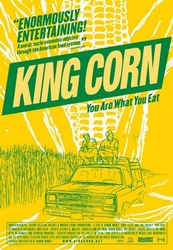 On the 38th anniversary of Earth Day, an entire generation of Americans born after the introduction of this much-mocked and undervalued holiday/celebration/day of pondering can now be affectionately referred to as the “Children of the Corn.†On the 38th anniversary of Earth Day, an entire generation of Americans born after the introduction of this much-mocked and undervalued holiday/celebration/day of pondering can now be affectionately referred to as the “Children of the Corn.â€
Anyone who pays the slightest attention to the ingredient lists of most of the food items sold at the conventional grocery stores across this country would know this, except the American consumer seems to do very little research while buying things that go directly into her body. This is why we need more investigative reporting and more documentary films on the subject of food. This is why King Corn, directed by Aaron Woolf, Ian Cheney and Curt Ellis, is important viewing for the average American consumer.
In King Corn, Woolf, Cheney (we hope of no relation the Cheneys of Wyoming) and Ellis spell out in very basic terms, what has gone so wrong with American agriculture and its direct product, American food. They present their hardest evidence first: Ellis and Cheney have their strands of hair analyzed at the University of Virginia. The result: the carbon in their bodies originated from corn. The two Ivy League grads seem shocked and appalled. They run to the grocery store and start reading labels of their favorite food products such as Twinkies and apple juice. They find out the obvious — most packaged foods in America contain some derivative of corn, whether it comes in the form of corn oil, the infamous and ubiquitous high fructose corn syrup or the mysterious xanthan gum.Â
Instead of doing the East Coast elitist exposé composed of interviews with nutritional and agricultural talking heads (which does happen in small bits in the latter half of the 90 minutes), the directors take a softer, more personal approach to the controversial subject.
Ellis and Cheney, best friends from Yale, decide to move to Iowa for a year and grow corn to find out what happens with it. It’s not quite as extreme as the personal sacrifice of Morgan Spurlock with Supersize Me! or as abrasive (yet entertaining) as Michael Moore with his ambush interviews, but it’s an effort at least appreciated by the rural farm folk of Iowa (at first.)
–Read the rest of this entry »
|
|
|
|
| |
|
|
|
|
|
|
|
By Bryan Newbury
January 21, 2008
 The United States became a debtor nation in 1989. It was the first time the U.S. could be so classified since World War I. From that point to the present, the red ink has ebbed and flowed, but largely expanded to the point where some economists and social scientists are predicting the kind of flood we saw in New Orleans a few years back. Your family’s share of the national debt is a cozy $90,000 and growing. The Chinese are holding the note, and, as William Greider wrote in 2004, “[t]he poker game ends when one major player or another decides it has gotten the last dollar off the table and it’s time to go home. Creditor nations naturally have the upper hand, like any banker who can call the loan when he sees the borrower is hopelessly mired.†How did we get to this point? The United States became a debtor nation in 1989. It was the first time the U.S. could be so classified since World War I. From that point to the present, the red ink has ebbed and flowed, but largely expanded to the point where some economists and social scientists are predicting the kind of flood we saw in New Orleans a few years back. Your family’s share of the national debt is a cozy $90,000 and growing. The Chinese are holding the note, and, as William Greider wrote in 2004, “[t]he poker game ends when one major player or another decides it has gotten the last dollar off the table and it’s time to go home. Creditor nations naturally have the upper hand, like any banker who can call the loan when he sees the borrower is hopelessly mired.†How did we get to this point?
Maxed Out doesn’t examine the foreign and economic policy big picture as much as it illustrates the situation through the credit problems of individual Americans. The parallels are unbearably odd, though the motivations and manipulations don’t correspond. As a debtor nation, we are seemingly going out of our way to leave ourselves vulnerable. As a matter of domestic policy, our leaders identify with the creditors (their American paymasters) leaving the working and middle class to the rapacious vultures of the banking and credit industry. Given this dichotomy, it would be nigh on impossible for the most skillful filmmaker to weave a coherent narrative connecting the debt crisis affecting Main Street Americans with the multi-trillion dollar deficit crunch of our government.
–Read the rest of this entry »
|
|
|
|
| |
|
|
|
|
|
|
|
By Bryan Newbury
January 2, 2008
 Near the end of January 2002, President Bush delivered a speech, and within it a line, that would shape the American psyche for some years to come. By declaring an “Axis of Evil,†the groundwork was laid for a public to be motivated by fear and hyperbole. Were it not for a number of brave people, make no mistake that the United States would be bombing Iran as this is written. Of course, the Iranians haven’t the capability – likely, they don’t have the desire – to manufacture a nuclear weapon. Even if they did, they would be unable to detonate the device anywhere near American soil, unless one counts the colony of Iraq. That hasn’t stopped us before. Near the end of January 2002, President Bush delivered a speech, and within it a line, that would shape the American psyche for some years to come. By declaring an “Axis of Evil,†the groundwork was laid for a public to be motivated by fear and hyperbole. Were it not for a number of brave people, make no mistake that the United States would be bombing Iran as this is written. Of course, the Iranians haven’t the capability – likely, they don’t have the desire – to manufacture a nuclear weapon. Even if they did, they would be unable to detonate the device anywhere near American soil, unless one counts the colony of Iraq. That hasn’t stopped us before.
As with most of the foreign policy posturing in the last six years, the exaggerations and bad faith declarations serve to obscure tangible threats to our republic and the world. One of the Axis members who has spent the last five years under the radar (insert physicality pun here) is the nation led by esteemed filmmaker, librettist and cargo jacket model Kim Jong Il.
–Read the rest of this entry »
|
|
|
|
|
|
 Recently, The New York Times ran a piece speculating upon what our thankfully nearly late decade should be dubbed. Among other ghastly appellations were The Era of Misplaced Anxiety and The Decade of Overshoot, to say nothing of the North going South and The Decade of Disruptions. Watching The Garden while looking back at the aughts, one is tempted to leap to hyperboles of wickedness so pernicious that he might be accused of striking at least a passing resemblance to the Yahwist.
Recently, The New York Times ran a piece speculating upon what our thankfully nearly late decade should be dubbed. Among other ghastly appellations were The Era of Misplaced Anxiety and The Decade of Overshoot, to say nothing of the North going South and The Decade of Disruptions. Watching The Garden while looking back at the aughts, one is tempted to leap to hyperboles of wickedness so pernicious that he might be accused of striking at least a passing resemblance to the Yahwist. Bitch set me up.
Bitch set me up. Outside of the District, and especially outside of the black community, the consensus is that Mr. Barry is a base pipe toking womanizer who has outlived his public usefulness. Inside of the District and its black community, the former is a forty-sixty proposition. The sixty readily identify with Mr. Barry’s trials and tribulations, having experienced the siege of narcotics and violence in their community, having lived through broken homes bought about in many respects by the willful efforts of the Anglo power structure to break those homes and communities. As the film points out early on, the District operated as an odd plantation protectorate well into the 1970’s, being administered by gents like John McMillan of South Carolina . Barry was indispensable in the fight to “Free D.C.†and make it possible for citizens of the overwhelmingly black city to enjoy basic rights other Americans take for granted, such as electing a city council and mayor.*
Outside of the District, and especially outside of the black community, the consensus is that Mr. Barry is a base pipe toking womanizer who has outlived his public usefulness. Inside of the District and its black community, the former is a forty-sixty proposition. The sixty readily identify with Mr. Barry’s trials and tribulations, having experienced the siege of narcotics and violence in their community, having lived through broken homes bought about in many respects by the willful efforts of the Anglo power structure to break those homes and communities. As the film points out early on, the District operated as an odd plantation protectorate well into the 1970’s, being administered by gents like John McMillan of South Carolina . Barry was indispensable in the fight to “Free D.C.†and make it possible for citizens of the overwhelmingly black city to enjoy basic rights other Americans take for granted, such as electing a city council and mayor.* By now, many of us have grown accustomed to films that make us uncomfortable.
By now, many of us have grown accustomed to films that make us uncomfortable. Slowly but surely, it also morphs from a ridiculous shaggy-love tale (our Romeo makes several MTV-style music videos he calls “love disks†and is shown mailing them to his beloved) to the real-life depiction of a good Christian girl (a playmate of one of the four girls killed in the 1963 bombing of the Sixteenth Street Baptist Church in Birmingham) and African-American scholar … who underwent a transformation into a corporate board fixture after whom an oil tanker was named, who enjoyed the assistance of affirmative action but punished and ignored others who did the same, who overlooked civil slaughter in Nigeria and lied about Iraq, and who okayed the torture of Muslim prisoners.
Slowly but surely, it also morphs from a ridiculous shaggy-love tale (our Romeo makes several MTV-style music videos he calls “love disks†and is shown mailing them to his beloved) to the real-life depiction of a good Christian girl (a playmate of one of the four girls killed in the 1963 bombing of the Sixteenth Street Baptist Church in Birmingham) and African-American scholar … who underwent a transformation into a corporate board fixture after whom an oil tanker was named, who enjoyed the assistance of affirmative action but punished and ignored others who did the same, who overlooked civil slaughter in Nigeria and lied about Iraq, and who okayed the torture of Muslim prisoners. The character of “Doggart†in the film is clearly depicted as being much less intelligent than the real filmmaker (a King’s College, Cambridge graduate in the social and political sciences, and veteran director of stage and TV documentaries on both sides of the Atlantic), just as Ratray (whose acting resume includes Buzz in two “Home Alone†movies and several episodes of “Law and Orderâ€) can’t possibly be as credulous and foolish as he appears in this movie. The climax (or nadir, depending on how you look at it) of their buddy relationship occurs midway through the movie when “Doggart†tries to convince “Ratray†during a beach shoot that the narrative arc demands a nude scene.
The character of “Doggart†in the film is clearly depicted as being much less intelligent than the real filmmaker (a King’s College, Cambridge graduate in the social and political sciences, and veteran director of stage and TV documentaries on both sides of the Atlantic), just as Ratray (whose acting resume includes Buzz in two “Home Alone†movies and several episodes of “Law and Orderâ€) can’t possibly be as credulous and foolish as he appears in this movie. The climax (or nadir, depending on how you look at it) of their buddy relationship occurs midway through the movie when “Doggart†tries to convince “Ratray†during a beach shoot that the narrative arc demands a nude scene. Things start to turn a little weirder – because less obviously farcical and futile – as Ratray and Doggart get Rice’s one and only ex-fiancé, former Denver Broncos receiver Rick Upchurch, to show his engagement ring and reminisce about their dates; then receive romantic advice and potential love songs from Grammy-winning composer and one-time Elvis girlfriend Carol Connors; and then put Devin through the image-making tutelage and focus-group grinder of Frank Luntz, campaign marketing wizard to a string of Republican politicians. Connors and Luntz strut their respective expertises, but they also play for the camera a little, and thereby induce a little extra vertigo in the viewer.
Things start to turn a little weirder – because less obviously farcical and futile – as Ratray and Doggart get Rice’s one and only ex-fiancé, former Denver Broncos receiver Rick Upchurch, to show his engagement ring and reminisce about their dates; then receive romantic advice and potential love songs from Grammy-winning composer and one-time Elvis girlfriend Carol Connors; and then put Devin through the image-making tutelage and focus-group grinder of Frank Luntz, campaign marketing wizard to a string of Republican politicians. Connors and Luntz strut their respective expertises, but they also play for the camera a little, and thereby induce a little extra vertigo in the viewer.  Last week, we saw an image of an American president that has been foreign to us for a little while. In Cairo, tens of thousands of Muslims cheered for President Barack Obama, as he spoke of a different world with a different United States leading it. He quoted from the three major Western religious texts and brought Egyptians to their feet with applause. As President Obama works on his second 100 days in the White House, it is a good time to take a look back and reflect on his campaign that brought him there.
Last week, we saw an image of an American president that has been foreign to us for a little while. In Cairo, tens of thousands of Muslims cheered for President Barack Obama, as he spoke of a different world with a different United States leading it. He quoted from the three major Western religious texts and brought Egyptians to their feet with applause. As President Obama works on his second 100 days in the White House, it is a good time to take a look back and reflect on his campaign that brought him there.


 Astra Taylor’s Zizek!, like the film’s namesake, provides a challenge to the reviewer in a way many ostensibly similar films – think You Can’t Be Neutral on a Moving Train and Manufacturing Consent – do not. There are quite a few reasons for this: brevity of run time; the difference between “activist†theoreticians, historians and philosophers like Zinn and Chomsky and the more urbane and inactivist bloke that Zizek personifies; the rarified air of Lacanian psychoanalysis versus the relative simplicity and utility of pure social science. In a sense, to wax postmodernist, the reviewer is burdened with the same role as the director. The observer is inside, aiming to describe a description, or depiction, that was the implicit purpose of the film itself.
Astra Taylor’s Zizek!, like the film’s namesake, provides a challenge to the reviewer in a way many ostensibly similar films – think You Can’t Be Neutral on a Moving Train and Manufacturing Consent – do not. There are quite a few reasons for this: brevity of run time; the difference between “activist†theoreticians, historians and philosophers like Zinn and Chomsky and the more urbane and inactivist bloke that Zizek personifies; the rarified air of Lacanian psychoanalysis versus the relative simplicity and utility of pure social science. In a sense, to wax postmodernist, the reviewer is burdened with the same role as the director. The observer is inside, aiming to describe a description, or depiction, that was the implicit purpose of the film itself. Life, death, dreams and rebellion… The French have always been extraordinarily talented in defying the mainstream Western cultures’ accepted notions on these. The last time the French were truly successful at jarring our sense of what is good – life, what is evil – human mortality, was done through New Wave cinema with the likes of Jean Luc Godard and Francois Truffaut.
Life, death, dreams and rebellion… The French have always been extraordinarily talented in defying the mainstream Western cultures’ accepted notions on these. The last time the French were truly successful at jarring our sense of what is good – life, what is evil – human mortality, was done through New Wave cinema with the likes of Jean Luc Godard and Francois Truffaut. Less than three months from a historic presidential election comes an extremely timely documentary from Docurama Films. The Robert Drew Kennedy Films Collection, including Primary, filmed in 1960, Crisis, filmed in 1963, and Faces of November, filmed in 1964, is a crucial trilogy for students of history and political junkies everywhere.Â
Less than three months from a historic presidential election comes an extremely timely documentary from Docurama Films. The Robert Drew Kennedy Films Collection, including Primary, filmed in 1960, Crisis, filmed in 1963, and Faces of November, filmed in 1964, is a crucial trilogy for students of history and political junkies everywhere. 



 A person’s views on the death penalty don’t just change. They evolve. When someone takes the time to investigate the process and the punishment, the only intelligent conclusion he can arrive at is that capital punishment is a barbaric miscarriage of justice. This seems to be the case At the Death House Door puts forward, and it would be difficult to argue to the contrary.
A person’s views on the death penalty don’t just change. They evolve. When someone takes the time to investigate the process and the punishment, the only intelligent conclusion he can arrive at is that capital punishment is a barbaric miscarriage of justice. This seems to be the case At the Death House Door puts forward, and it would be difficult to argue to the contrary. On the 38th anniversary of Earth Day, an entire generation of Americans born after the introduction of this much-mocked and undervalued holiday/celebration/day of pondering can now be affectionately referred to as the “Children of the Corn.â€
On the 38th anniversary of Earth Day, an entire generation of Americans born after the introduction of this much-mocked and undervalued holiday/celebration/day of pondering can now be affectionately referred to as the “Children of the Corn.â€ The United States became a debtor nation in 1989. It was the first time the U.S. could be so classified since World War I. From that point to the present, the red ink has ebbed and flowed, but largely expanded to the point where some economists and social scientists are predicting the kind of flood we saw in New Orleans a few years back. Your family’s share of the national debt is a cozy $90,000 and growing. The Chinese are holding the note, and, as William Greider wrote in 2004, “[t]he poker game ends when one major player or another decides it has gotten the last dollar off the table and it’s time to go home. Creditor nations naturally have the upper hand, like any banker who can call the loan when he sees the borrower is hopelessly mired.†How did we get to this point?
The United States became a debtor nation in 1989. It was the first time the U.S. could be so classified since World War I. From that point to the present, the red ink has ebbed and flowed, but largely expanded to the point where some economists and social scientists are predicting the kind of flood we saw in New Orleans a few years back. Your family’s share of the national debt is a cozy $90,000 and growing. The Chinese are holding the note, and, as William Greider wrote in 2004, “[t]he poker game ends when one major player or another decides it has gotten the last dollar off the table and it’s time to go home. Creditor nations naturally have the upper hand, like any banker who can call the loan when he sees the borrower is hopelessly mired.†How did we get to this point? Near the end of January 2002, President Bush delivered a speech, and within it a line, that would shape the American psyche for some years to come. By declaring an “Axis of Evil,†the groundwork was laid for a public to be motivated by fear and hyperbole. Were it not for a number of brave people, make no mistake that the United States would be bombing Iran as this is written. Of course, the Iranians haven’t the capability – likely, they don’t have the desire – to manufacture a nuclear weapon. Even if they did, they would be unable to detonate the device anywhere near American soil, unless one counts the colony of Iraq. That hasn’t stopped us before.
Near the end of January 2002, President Bush delivered a speech, and within it a line, that would shape the American psyche for some years to come. By declaring an “Axis of Evil,†the groundwork was laid for a public to be motivated by fear and hyperbole. Were it not for a number of brave people, make no mistake that the United States would be bombing Iran as this is written. Of course, the Iranians haven’t the capability – likely, they don’t have the desire – to manufacture a nuclear weapon. Even if they did, they would be unable to detonate the device anywhere near American soil, unless one counts the colony of Iraq. That hasn’t stopped us before.


